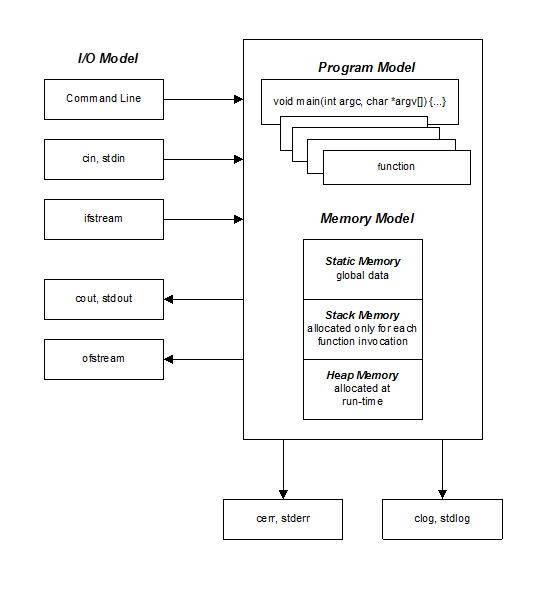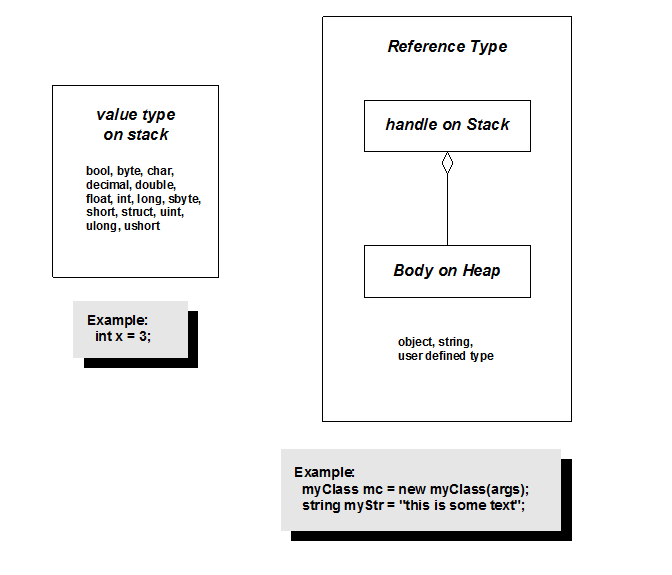about
Blog: Object Models
11/26/2024
Blog: Object Models
native code, managed code
About
click to toggle Site Explorer
Initial Thoughts:
-
C++ Native Code
The C++ Programming Language was built, from the ground up, to support creation of user-defined value types. For this it supports copy construction
and copy assignment. If a class's members and bases all have value semantics, the compiler will generate default copy and assignment operations
that provide value semantics for the class, by doing member-wise copy and assignment. If a class composes reference types, then the class designer
overloads the class copy constructor and assignment operator to provide correct value semantics.
C++ programs can store instances of any type in static, stack, or heap memory. This includes user defined types as well as language primitives. Storage in static memory persists for the lifetime of the program. Storage in stack memory persists while execution remains in the scope where the object is created. Heap memory storage persists from the time of creation with a call to new until destruction caused by a call to delete. For local objects1, allocation and deallocation of resources is all scope based. A native object allocates its resources in a constructor at the point of declaration and deallocates its resources in a destructor. If the object resides in stack memory that happens when the thread of execution leaves the scope in which the object was constructed. If the object resides in static memory the destructor is called when the program ends. If the object resides in the native heap destruction happens when requested by the program with a call to delete or when the program ends. This is a very natural and elegant way to manage resources. C++ provides the ability to copy construct, copy assign, move construct, and move assign instances of a class that provides copy and move constructors and copy and move assignment operator overloads. The copy constructor makes a new instance with initial state identical to the state of the source instance. Copy assignment copies the state of the assignment source instance to the destination instance. Move operations are similar except that the source gives up ownership of its state to the destination. Usually this can be done very efficiently, often with only a pointer swap. As we discuss below, the Java and C# object models do not provide these capabilities. Class Relationships

-
C# and Java Managed Code
Both these languages define two kinds of types: value types and reference types, each with its own object model. Value types are arithmetic types and structs. Reference types are all instances of types defined by the language and the user with classes. Value types are all stack or static based and have only a predefined default constructor. They have no destructors. Thus the memory they are allocated is simply reallocated to other type instances when they go out of scope. A program can construct unique copies of value types2. Managed programs can store handles to reference types in static and stack memory. Managed classes may compose handles to instances of reference types on the managed heap. We say that the class "aggregates" the referenced instance in the managed heap. Reference types can have parameterized constructors that allocate managed and unmanaged3 resources to the class. Java classes have finalizers but no destructors. C# classes can define a destructor but that acts as a finalizer, e.g., is called by the garbage collector when the instance is being deallocated. In general, it is not possible to make a unique copy of a reference type without using serialization. Note that, unlike C++, C# and Java do not support the definition of a copy constructor. The reason for this is that reference types are accessed through handles. Copying a handle just makes another reference to the underlying object. If a class holds only value type data members, then it is possible to make a clone by creating a new object and copying the source objects value members. That is what happens when you make a copy of a Java or C# string. When a handle goes out of scope or is set to null its associated object is enqueued for garbage collection. When the collector runs the object will be destroyed only if there are no other references pointing to the object. This is a non-deterministic process so the program has no direct control over the deallocation of resources unless the object's class defines a Dispose method. Dispose is used to return unmanaged resources used by the class when called, but that does not deallocate the memory associated with the object. That can only be done by the garbage collector. Also, unlike the C++ object model, every user must participate in calling the Dispose function. If the user forgets or doesn't know the instance is disposable, then release of the unmanaged resources must wait for garbage collection.

- Javascript Javascript has value types, e.g., ints, bools, literal strings, and reference types which are instances that reside on a managed heap. Javascript uses a prototype object model. New instances are created by cloning a prototype and removed from memory by garbage collection when all references to them have been nulled or gone out of scope. Most applications of Javascript are hosted by browsers. However, in the Node.js framework, a host for the Chrome V8 Javascript engine has been developed for Windows, Linux, and Unix applications. Node supports TCP communication and uses a single-threaded message loop, similar to the loop used in virtually all GUI applications. Javascript objects are dynamically typed. They behave very like C Language structs that contain instances or references to data and pointers to functions. New functions and new data can be added to an instance at any time.
- A local object is defined inside some scope, e.g., function scope or control scope.
- Value types are, with one exception, blit-able, e.g., can be copied by copying memory. Structs are value types, but may not be blit-able since the languages, suprisingly, allow structs to hold references.
- Unmanaged resources are things like I/O streams, database connections, and socket handles.
